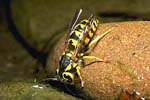 Description: 1/2-5/8" (12-16 mm). Body stout, slightly wider than head. Abdomen narrow where attached to thorax with short "waist" (pedicel). 1st antennal segment yellow, 2nd and subsequent segments black. Head, thorax, and abdomen black and yellow or white. Wings smoky.
Description: 1/2-5/8" (12-16 mm). Body stout, slightly wider than head. Abdomen narrow where attached to thorax with short "waist" (pedicel). 1st antennal segment yellow, 2nd and subsequent segments black. Head, thorax, and abdomen black and yellow or white. Wings smoky.
- Warning Workers will sting repeatedly if they perceive you as a threat to their nest, otherwise, they are less aggressive.
- Food Adult eats nectar. Larva feeds on insects pre-chewed by adults.
- Life Cycle In spring mated female constructs small nest and daily brings food to larvae until 1st brood matures and females serve as workers, extending nest and tending young. In late summer males develop from unfertilized eggs and mate. When cold weather begins, all die except mated females, which over winter among litter and in soil.
- Habitat Meadows and edges of forested land, usually nesting in ground or at ground level in stumps and fallen logs.
- Range: Throughout North America; various species more localized.
- Yellow jackets can be pests at picnics, and they will carry off bits of food. If the nest can be found and its opening covered at night with a transparent bowl set firmly into the ground, adults will be confused by their inability to escape and seek food in daylight; they will not dig a new escape hole and will soon starve to death. The Western Yellow Jacket (V. Pennsylvania) and Eastern Yellow Jacket (V. maculifrons) are similarly colored, except the first antennal segment of the latter is all black.